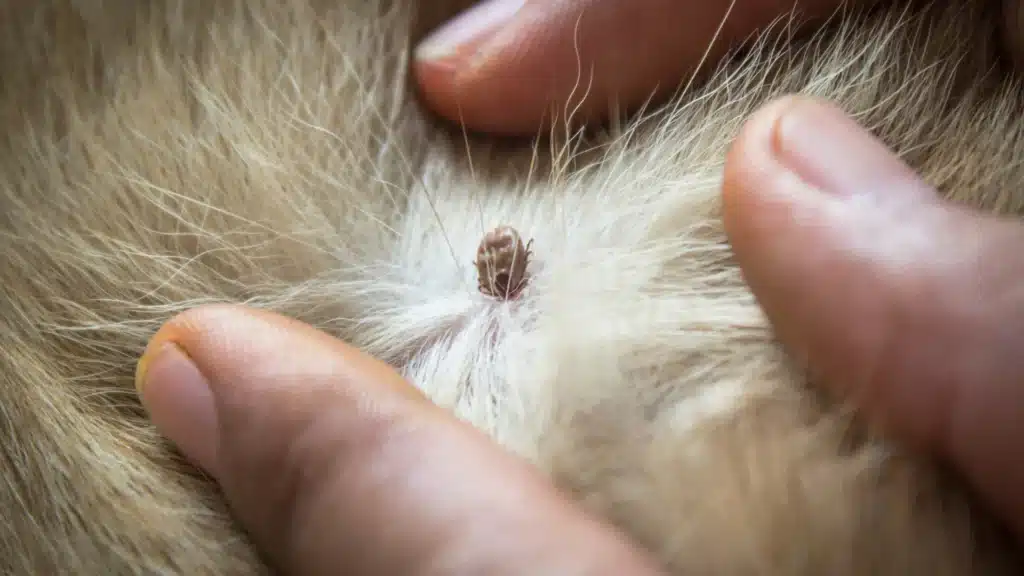Lyme Disease in Dogs: Symptoms, Treatment, and Prevention
There’s nothing like watching your dog out in nature, just wandering around, sniffing everything, wagging their tail, and taking in all those incredible smells from nature. But as pet owners, it’s important to be aware of hidden dangers, like ticks, that can pose serious health risks to our pets. One of the most common tick-borne illnesses is Lyme disease, which can affect both humans and dogs.
With the right knowledge and care, you can help protect your dog from Lyme disease and keep those outdoor adventures safe and fun. In this post, we’ll walk you through Lyme disease, how it can affect your pup, and, most importantly, how to prevent it.
What is Lyme Disease?
Lyme disease, a potentially severe illness, is primarily transmitted through the bite of infected black-legged ticks, also known as deer ticks. The bacteria is typically passed on to the dog after the tick has been attached for 24 to 48 hours. These tiny parasites can carry the bacterium *Borrelia burgdorferi*, which is the causative agent of the disease. While it is commonly associated with humans, Lyme disease can also affect dogs, causing a range of health problems if not promptly addressed.
These ticks thrive in wooded and grassy areas, posing a significant risk to dogs that frequent such environments. Once an infected tick latches onto a dog and transmits *Borrelia burgdorferi*, it can lead to the development of the disease.

What is the Bacterium: Borrelia burgdorferi
Borrelia burgdorferi (let’s call it B. burgdorferi for short!) is a type of bacteria known as a spirochete. This means it has a spiral shape, almost like a little corkscrew. What makes this bacterium tricky is that it doesn’t live on its own in the environment. Instead, it gets transmitted through the bites of infected black-legged ticks, also called deer ticks. These ticks pick up the bacteria by feeding infected wildlife, like mice and deer. The tick then latches onto your dog and feeds, the bacteria can enter your dog’s bloodstream and begin to spread.
The Tick
Pet owners must understand the tick’s life cycle and where it lives to take preventive measures to keep their dogs safe.
Ticks have four life stages: egg, larva, nymph, and adult. Both nymphs and adults can transmit Lyme disease. Nymphs are particularly problematic because of their small size, making them more challenging to detect in a host’s body, increasing the likelihood of disease transmission.
Ticks are often found in wooded areas, tall grasses, and shrubs, where they wait for a passing host. They are most active during the warmer months, from spring through fall. However, in certain regions with milder climates, ticks can remain active year-round, posing a risk to humans and animals.
What Are the Symptoms of Lyme Disease in Dogs?
Not all dogs infected with Lyme disease will show symptoms, making early detection a little hard. When symptoms do appear, they often occur in weeks or even months after the tick bite. Keep an eye out for the following signs:
- Lameness and Joint Pain: One of the most common symptoms of Lyme disease is what’s called “shifting-leg lameness.” This means your dog might suddenly limp on one leg, only for the limp to switch to another leg a what’s later. “Joint pain and inflammation “can cause your dog to move more slowly or become reluctant to walk or play.
- Fatigue and Lethargy: If your usually happy-go-lucky pup seems tired, slow, or not into their favourite activities, it might mean something’s off. Lyme disease can really drain a dog’s energy as they battle the infection.
- Fever: Dogs with Lyme disease may experience a fever, making them feel uncomfortable and more fatigued than usual. You might notice them lying down more often or seeking cool, quiet places to rest.
- Loss of Appetite: A dog that doesn’t want to eat might not feel well even when offered a favourite treat. Loss of appetite is a common symptom of many illnesses, including Lyme disease.
- Swollen Lymph Nodes: In some cases, dogs with Lyme disease may develop swollen lymph nodes, which are part of the body’s immune response to infection. This can sometimes be felt as lumps under the jaw or other body parts.
- Kidney disease: In rare cases, Lyme disease can lead to a severe condition called Lyme nephritis, which can cause kidney inflammation. Some symptoms include vomiting, increased thirst and urination, and weight loss. If left untreated, kidney disease can be life-threatening.
Diagnosing Lyme Disease
When Lyme disease is suspected in a dog, immediate veterinary care is imperative. Diagnosis typically involves blood tests to detect antibodies against Borrelia burgdorferi. Veterinary professionals commonly employ the following diagnostic methods to identify Lyme disease in dogs:
- Serologic Testing: ELISA and Western Blot tests frequently detect antibodies against Borrelia burgdorferi in dogs.
- C6 Antibody Test: This test is specifically designed to identify antibodies against the C6 peptide of the bacterium, aiding in confirming an active infection.
- Quantitative C6 Test: This test measures antibody levels, providing valuable insights into the severity of the infection.
It is vital to Differentiate Lyme disease from other conditions that exhibit similar symptoms, such as other tick-borne diseases, autoimmune disorders, and orthopedic issues. Veterinary professionals utilize their skills and diagnostic tools to accurately identify Lyme disease and rule out other potential health problems in dogs.
Treatment Options for Lyme Disease
Lyme disease treatment in dogs is primarily focused on administering antibiotics, with early detection and prompt treatment being crucial in preventing disease progression and minimizing potential complications. The mainstay of Lyme disease treatment in dogs involves antibiotics, possibly requiring additional supportive care. While this approach generally leads to a rapid resolution of symptoms, the infection may persist in certain cases, necessitating an extended course of medication. Antibiotic therapy for Lyme disease in dogs may include Doxycycline, the most frequently prescribed antibiotic, typically administered for 4 weeks. Another option is Amoxicillin, which may be an alternative to Doxycycline, particularly for younger dogs or those unable to tolerate Doxycycline. In addition to antibiotic therapy, your veterinarian may prescribe nonsteroidal anti-inflammatory drugs (NSAIDs) to alleviate joint pain and inflammation.
Preventive Measures
Preventing Lyme disease is easier than treating it. Pet owners can take several steps to reduce the risk of tick bites and subsequent infection. These steps include:
- Tick Prevention: Products applied to the dog’s skin to kill ticks upon contact.
- Oral Medications: Pills that kill ticks when they bite the dog.
- Tick Collars: Collars that release chemicals repelling or killing ticks.
- Yard Maintenance: Keep the lawn mowed and remove leaf litter and tall grasses.
- Tick Checks: Regularly check the dog for ticks, especially after outdoor activities, and promptly remove any found.
- Vaccination: A Lyme disease vaccine is available for dogs, providing additional protection.
Frequently Asked Questions about Lyme Disease in Dogs
- Can Lyme Disease in Dogs be Cured? Unfortunately, certain dogs may continue to endure lingering symptoms even after receiving treatment for Lyme disease. Consequently, they may need ongoing care and support to maintain their health and well-being.
- How Long After a Tick Bite Do Symptoms Appear? Lyme disease symptoms in dogs may manifest 2 to 5 months following a tick bite.
- Can Humans Contract Lyme Disease from Infected Dogs? Lyme disease cannot be directly transmitted from dogs to humans. However, ticks feeding on infected dogs can transmit the disease to humans. Therefore, taking measures to control tick exposure is crucial to protect the health of both pets and humans.
- What Should I Do if I Find a Tick on My Dog? When removing a tick, it’s essential to utilize fine-tipped tweezers or a tick removal tool to firmly grasp the tick as close to the skin surface as possible. Pull straight out and with an even, steady pressure. Avoid twisting or jerking the tick; anything left behind can lead to infection. Be patient and apply slow, constant pulling until the tick releases its grip, which may take a minute or two. After removal, it’s essential to disinfect the bite area and thoroughly wash hands. Monitor the dog for any Lyme disease symptoms, and if any signs are observed, promptly seek guidance from a veterinarian.
- Are Certain Breeds More Susceptible to Lyme Disease? Lyme disease can affect all dog breeds, but those who frequently spend time outdoors in areas where ticks are common are at a higher risk of contracting the disease.
- Can I Catch Lyme Disease From My Dog? The risk of Lyme disease transmission from dogs to humans is extremely low. Dogs do not directly transmit Lyme disease to humans, which can only be transmitted through tick bites. However, if a tick carrying the Lyme disease bacteria latches onto your dog and later enters your home, it could potentially land on your dog’s fur and then get on you.
Lyme disease in dogs is a significant health concern that demands relentless management and proactive care from pet owners. We can guarantee our pets lead healthier and happier lives by staying up-to-date on prevention methods, conducting regular tick inspections, and promptly seeking veterinary care at the first sign of Lyme disease. Let us continue to enjoy our outdoor adventures with our dogs by prioritizing their health and well-being. We can shield our pets from Lyme disease and other avoidable health hazards by remaining well-informed and attentive.
